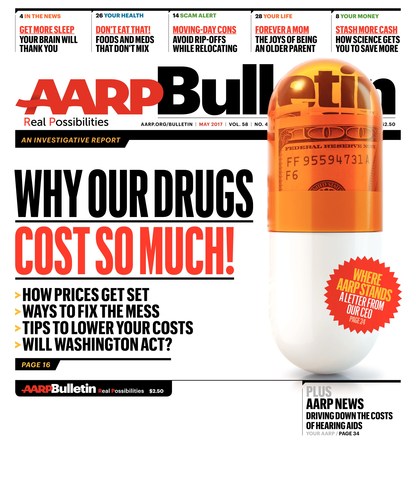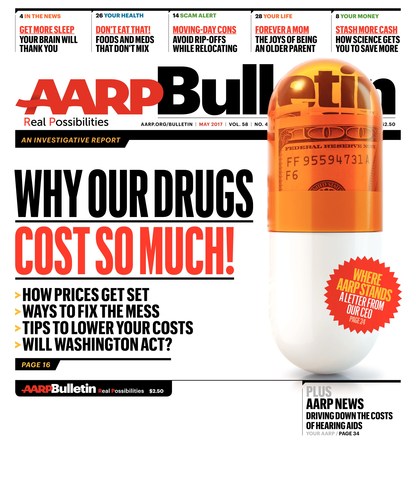May AARP Bulletin: An Investigative Report on Why Prescription Drugs Cost So Much
Plus, The Grandparent Boom, Don't Eat This if You're Taking That; Behavioral Economics: How We are Nudged into Doing the Right Thing; When to Get Disability Insurance; Why It's Important to Have a Will; and More
WASHINGTON, DC — President Trump said recently that drug companies are "getting away with murder." But the truth is the high prices drug companies charge for prescription medicine in America are not only perfectly legal, but generate profits that make them among the most successful businesses in the world. In this month's issue, AARP Bulletin offers a comprehensive investigative report on why drugs cost what they do. "Why Our Drugs Cost So Much!" details how the complicated business of medicine actually works, examines the drug-price debate in Washington, and provides advice on how to save money at the pharmacy. It also lays out the best ways to rein in drug costs for all Americans, and what the industry as well as regulators is beginning to do to address this critical health issue.

AARP CEO Jo Ann Jenkins then lays out AARP's clear position on the issue, and addresses how drug prices fit in to the larger issue of safe, affordable health care in America for all people over 50. In the past 10 years, the average cost for a year's supply of chronic illness medication has more than doubled to $11,000. In her column, "Let's Cut Drug Costs," Jenkins stands by AARP's long history of advocating for lower prescription drug prices, declaring that it's a priority to work with the Trump administration and Congress to continue that fight.
Other stories in the May issue:
The Grandparent Boom
It's official: the baby boom has now become the grandparent boom! With 70 million grandparents in the U.S., there are more nanas and pop pops spoiling their families than ever before. The same boomers who famously doted on their children now have their sights set on the next generation. This month's issue reveals the lavish amount grandparents have spent on their grandchildren alone in the past year.
Don't Eat This if You're Taking That
Did you know that the foods you eat and the medications you take could be working against each other? The truth is that harmful interactions aren't limited to competing drugs you ingest; anything you put in your body can potentially alter a medication's effectiveness or cause other problems. In this month's issue, Madelyn Fernstrom, a nutrition and diet expert featured on NBC's "Today," and her husband, John Fernstrom, an award-winning neuroscientist and pharmacologist, serve up some important dietary guidance from their new AARP book, Don't Eat This if You're Taking That.
How We are Nudged into Doing the Right Thing by Behavioral Science
You may not realize it, but the world of business and finance is becoming masterful at coercing you to do the right thing. Banks, companies and even the government are increasingly using behavioral science to get you to make better financial decisions. AARP Bulletin reveals the ins and outs of behavioral economics, one of the most successful ways to encourage consumers to save for retirement, make investment decisions easier and manage cash smarter.
When to Get Disability Insurance
Most Americans rate their chances of suffering from a disability during their working lives at about one in 50 or more. However, the reality is that one in eight will become disabled for five or more years during their career, with people age 50 or older accounting for 59 percent of disability claims. AARP Bulletin shares the five steps to determining if you've got the protection you need through your employer, or if it's best to buy your own policy independently.
Don't Need a Will? Think Again
Does everybody need a will? Spoiler alert: The answer is yes, and it's true even for people who think they don't have a dime to leave anyone. AARP Bulletin's May issue provides insight on the detriments of dying without having drafted a will and how to make a reliable one, with or without a lawyer.
Learn more at http://www.aarp.org/bulletin/. Interviews with AARP's experts are available upon request.
# # #
About AARP Bulletin
AARP Bulletin is the definitive news source for AARP's members. The Bulletin reaches more than 30 million readers through each of its ten print editions annually, with additional news and in-depth coverage online. AARP Bulletin delivers the story behind the key issues confronting Americans 50 and older, including health and health policy, Medicare, Social Security, consumer protection, work, personal finance, and AARP state and national news. The consumer-oriented news publication has become a must-read for congressional lawmakers and Washington opinion leaders, and it provides AARP members with pertinent information they need to know. Learn more at http://www.aarp.org/bulletin/.
About AARP
AARP is the nation's largest nonprofit, nonpartisan organization dedicated to empowering Americans 50 and older to choose how they live as they age. With nearly 38 million members and offices in every state, the District of Columbia, Puerto Rico, and the U.S. Virgin Islands, AARP works to strengthen communities and advocate for what matters most to families with a focus on health security, financial stability and personal fulfillment. AARP also works for individuals in the marketplace by sparking new solutions and allowing carefully chosen, high-quality products and services to carry the AARP name. As a trusted source for news and information, AARP produces the world's largest circulation publications, AARP The Magazine and AARP Bulletin. To learn more, visit www.aarp.org or follow @AARP and @AARPadvocates on social media.
For further information: Paola Torres, AARP, 202-434-2555, ptorres@aarp.org
Sheena Bermingham, Coburn Communication, 212-730-7045, sheena.bermingham@coburnww.com

































































